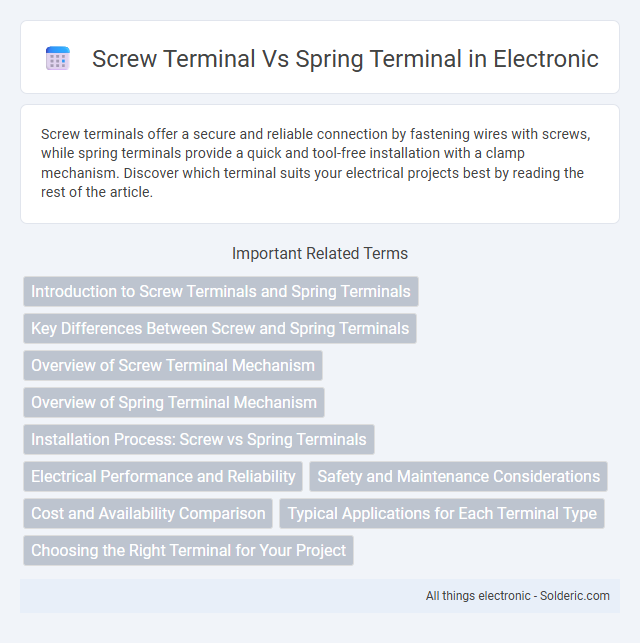Screw terminals offer a secure and reliable connection by fastening wires with screws, while spring terminals provide a quick and tool-free installation with a clamp mechanism. Discover which terminal suits your electrical projects best by reading the rest of the article.
Comparison Table
| Feature | Screw Terminal | Spring Terminal |
|---|---|---|
| Connection Method | Secures wire by tightening a screw | Uses a spring mechanism to hold wire |
| Installation Speed | Slower; requires screwdriver | Faster; tool-free operation |
| Wire Types Supported | Solid and stranded wires | Best for solid wires, some accept stranded |
| Connection Security | Very secure, reliable under vibration | Good but can loosen over time |
| Maintenance | Requires periodic screw tightening | Usually maintenance-free |
| Cost | Generally lower cost | Typically higher cost |
| Applications | Industrial, permanent installations | Quick-connect, modular, and DIY uses |
Introduction to Screw Terminals and Spring Terminals
Screw terminals secure electrical wires by tightening a metal screw onto a conductor, offering a reliable and robust connection preferred in high-vibration environments and heavy-duty applications. Spring terminals use a spring-loaded mechanism to clamp wires quickly and evenly, enabling faster installation and maintenance while maintaining consistent pressure over time. Both terminal types are essential in electrical circuits, with screw terminals favored for durability and spring terminals for ease of use and vibration resistance.
Key Differences Between Screw and Spring Terminals
Screw terminals utilize a threaded fastener to securely clamp wires, ensuring strong mechanical and electrical connections ideal for high-vibration environments. Spring terminals rely on a spring mechanism to hold wires in place, offering faster installation, easier maintenance, and better vibration resistance without the need for tools. The key differences include installation speed, connection security, and suitability for varying wire types and environmental conditions.
Overview of Screw Terminal Mechanism
Screw terminals secure wires by clamping them under a tightened screw, creating a reliable mechanical connection that resists vibration and loosening. This mechanism allows for easy inspection and reusability, making it suitable for applications requiring strong and stable electrical contacts. Your wiring benefits from the durable and robust nature of screw terminals, especially in environments where connection integrity is critical.
Overview of Spring Terminal Mechanism
Spring terminals use a simple, tension-based mechanism where a metal spring clamps down on the wire, providing secure and vibration-resistant connections without the need for screws. This design allows for quicker and easier wiring, especially in tight spaces or when frequent changes are needed. Your choice of spring terminal can enhance reliability and reduce installation time compared to traditional screw terminals.
Installation Process: Screw vs Spring Terminals
Screw terminals require tightening screws to secure wires, offering a reliable and durable connection suitable for permanent installations but demanding more time and tools during installation. Spring terminals use a spring mechanism to clamp wires instantly, enabling faster and easier installation without tools, ideal for repetitive wiring tasks or installations in confined spaces. The choice between screw and spring terminals significantly impacts installation speed, complexity, and long-term maintenance requirements.
Electrical Performance and Reliability
Screw terminals offer strong mechanical clamping, ensuring a stable and low-resistance electrical connection that is less prone to loosening under vibration, making them reliable for high-current applications. Spring terminals provide consistent contact pressure through a spring mechanism, enhancing vibration resistance and reducing the risk of connection failure due to wire fatigue, ideal for compact and high-density circuit designs. Your choice between screw and spring terminals should consider the need for durability under mechanical stress and maintenance frequency to optimize electrical performance and long-term reliability.
Safety and Maintenance Considerations
Screw terminals offer secure connections through tightened screws, reducing the risk of wire loosening, but they require periodic checking to maintain safety and performance. Spring terminals provide quick, tool-free wire connections that are less prone to loosening under vibration, enhancing safety by minimizing maintenance needs. Your choice should consider ease of maintenance and the operating environment to ensure reliable and safe electrical connections.
Cost and Availability Comparison
Screw terminals tend to be more affordable due to their simpler design and widespread manufacturing, making them readily available in most hardware and electronics stores. Spring terminals usually cost slightly more because of their intricate internal mechanism, though they offer faster installation and better vibration resistance. Both types are commonly stocked, but screw terminals dominate in price-sensitive projects while spring terminals are preferred when quick, secure connections are required.
Typical Applications for Each Terminal Type
Screw terminals are commonly used in industrial equipment, control panels, and heavy-duty electrical connections where secure and reliable contact is critical under high vibration or load conditions. Spring terminals are preferred in consumer electronics, lighting fixtures, and small appliances due to their quick installation, tool-free operation, and vibration resistance. Your choice between screw terminal vs spring terminal should consider application requirements for durability, maintenance, and ease of wiring.
Choosing the Right Terminal for Your Project
Choosing the right terminal for your project involves evaluating factors such as vibration resistance, ease of installation, and maintenance requirements. Screw terminals provide reliable, secure connections ideal for heavy-duty or high-vibration environments, while spring terminals offer faster installation and better performance in compact spaces. Your project's specific needs for durability and accessibility will determine whether screw or spring terminals deliver optimal electrical connection efficiency.
Screw terminal vs Spring terminal Infographic

 solderic.com
solderic.com